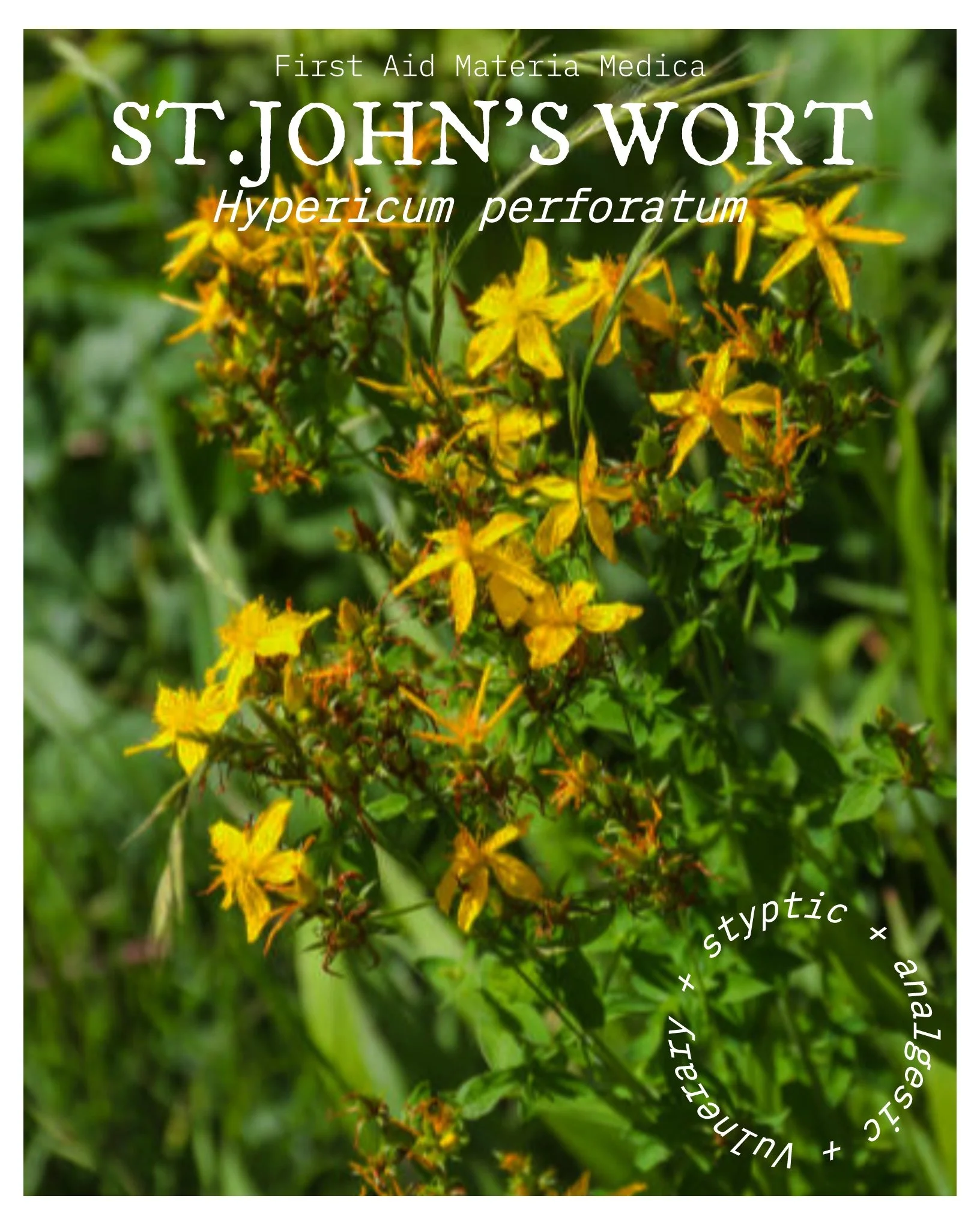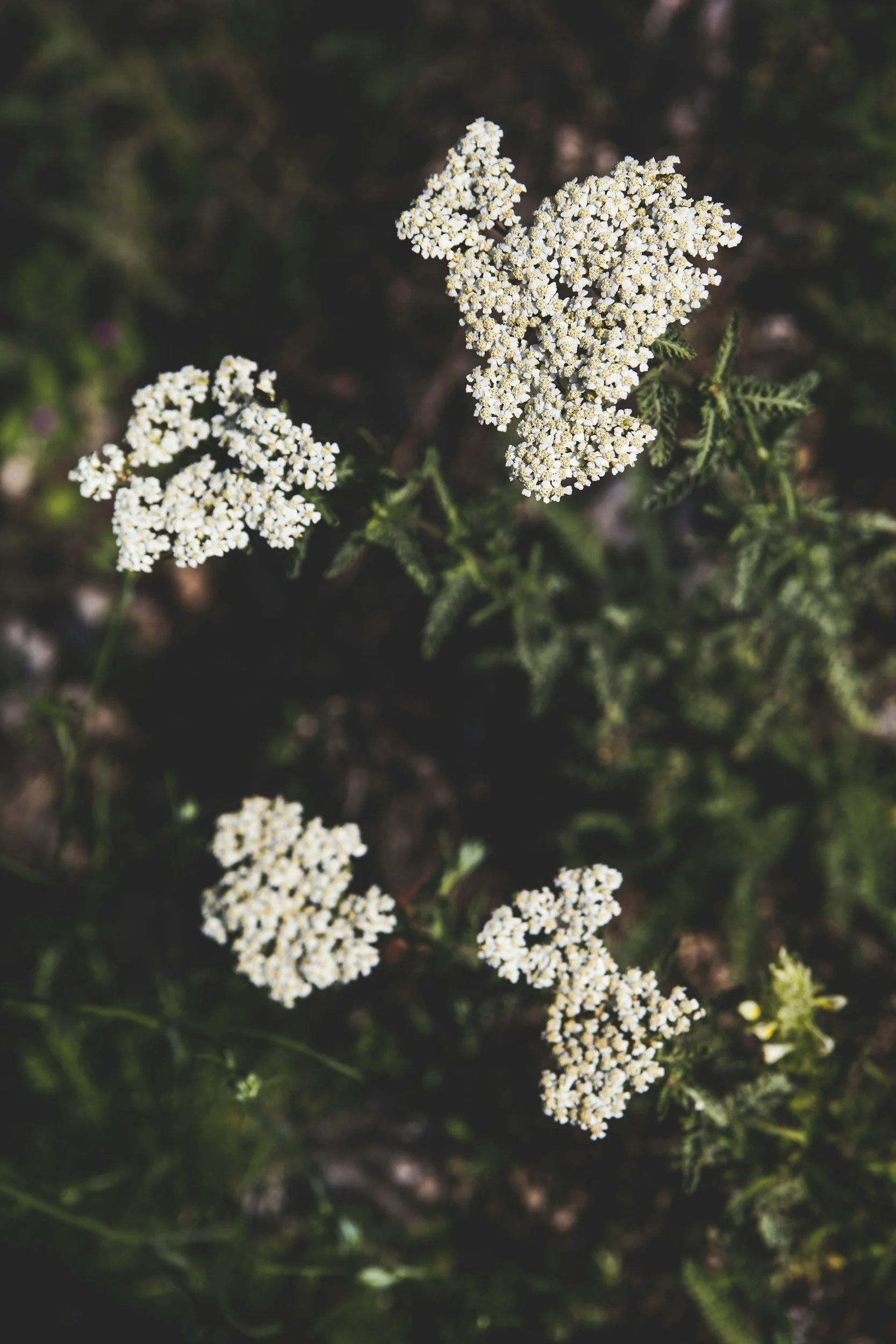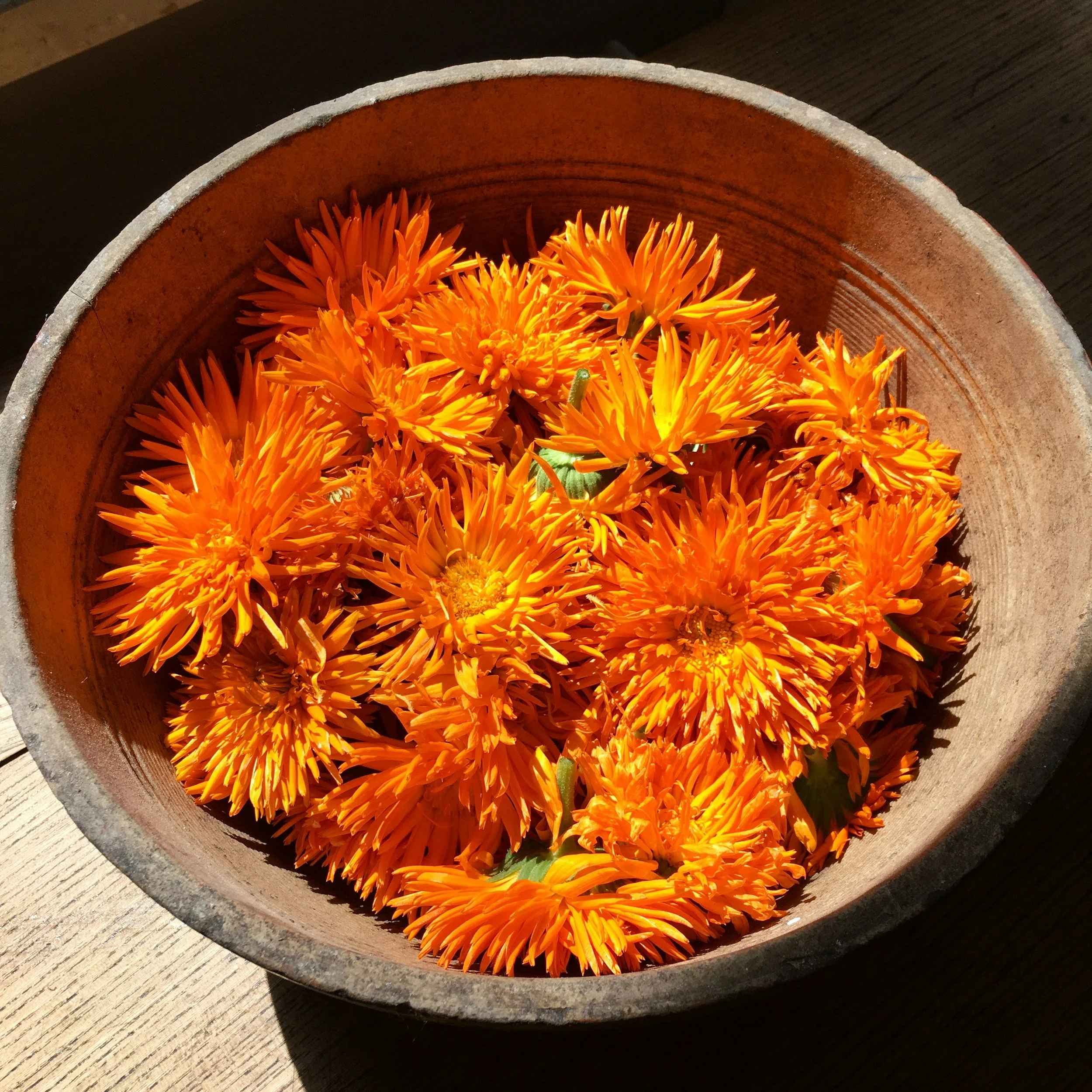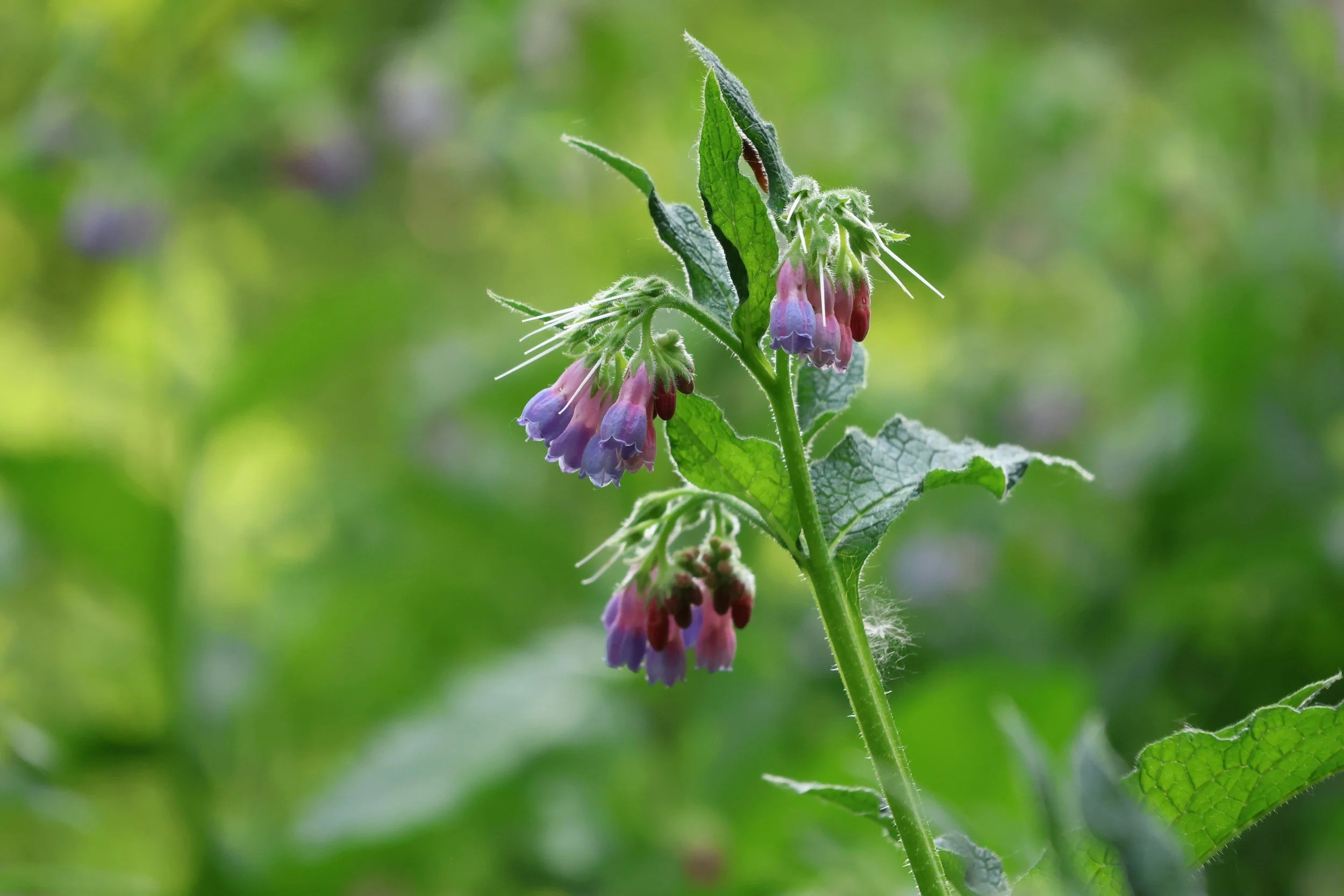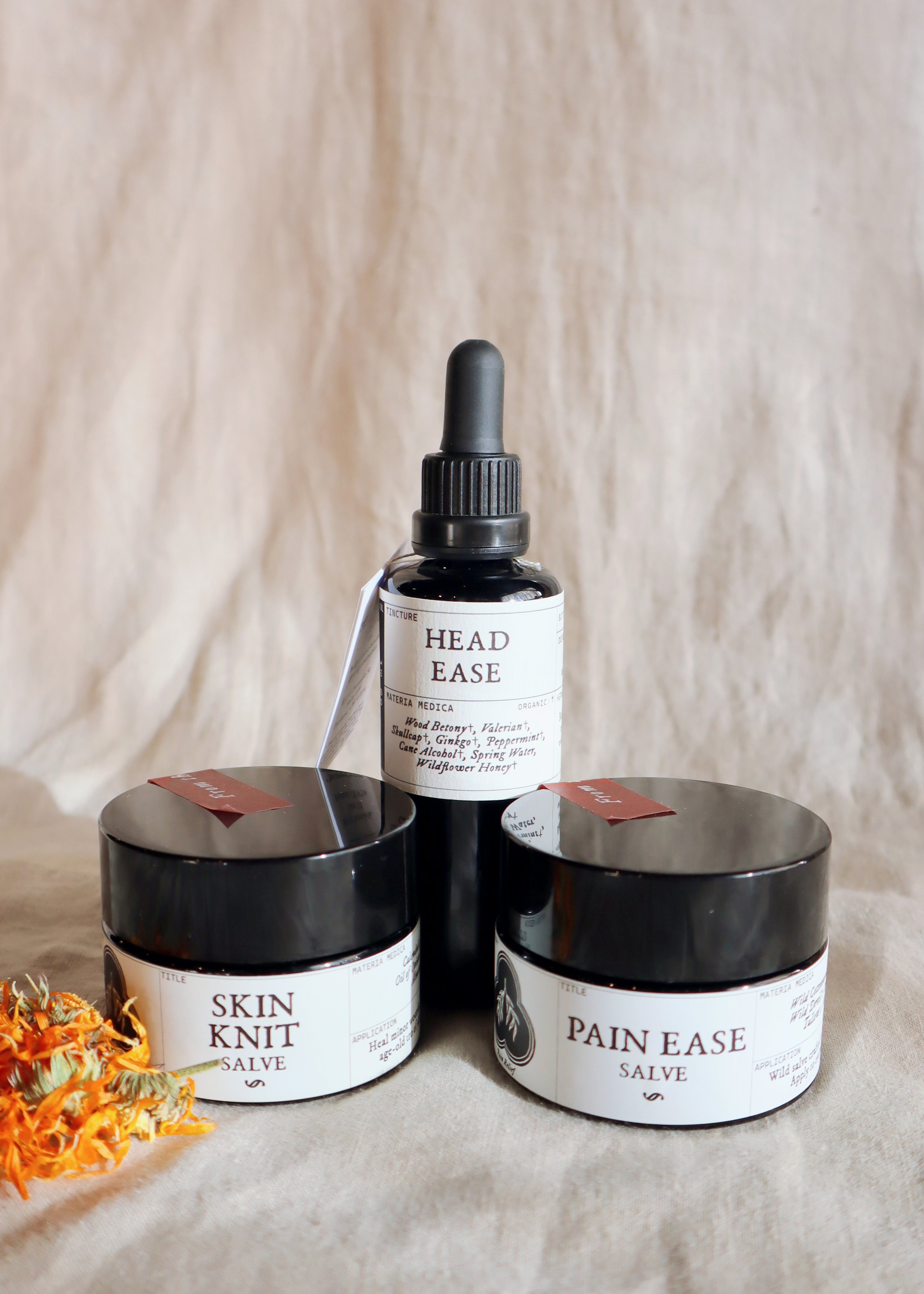Herbal First Aid
Whether spending time by the river in the summertime or chopping turnips for a hearty soup in the winter, knowing how to tend to basic wounds and injuries with herbs around you or on hand can be both empowering and life saving. Read on to learn about herbal first aid plants and medicine making!
HERBAL ACTIONS
+ Vulnerary - this term refers to plants used in the healing of wounds. Most vulnerary herbs contain tannins and usually have inflammation modulating and antiseptic properties that support wound healing.
+ Styptic - stops bleeding
+ Analgesic - Acts to relieve pain
+ Anti-fungal - Prevents fungal growth
+ Anti-inflammatory - Reduces inflammation - ie. swollen, red, hot, irritated
+ Anti-microbial - Kills or slows the spread of microorganisms - ie. viruses or bacteria that cause infection.
+ Cell proliferant - promotes cell growth/the healing of wounds.
NOTABLE FIRST AID PLANTS
+ Yarrow (Achillea millefolium) - styptic
+ Calendula (Calendula officionalis) - vulnerary, anti fungal, anti-inflammatory, cell proliferant
+ Comfrey (Symphytum officinal) - styptic, cell proliferant
+ Saint John’s Wort (Hypericum perforatum) - vulnerary, styptic, analgesic
+ Cottonwood (Poplar spp.) - pain, itchiness, rashes
+ Self-Heal (Prunella vulgaris) - vulnerary
+ White Willow (Salix alba) - analgesic, vulnerary
+ Oregon Grape (Mahonia spp.) - anti-fungal, anti-bacterial
+ Arnica (Arnica spp.) - analgesic
+ Plantain (Plantago spp.) - vulnerary, drawing action
+ Peppermint (Mentha piperita) - relieves nausea
FIRST AID APPLICATIONS
Wound Care
Yarrow staunches bleeding.
Pack your wound with dried yarrow, powdered yarrow, fresh yarrow, truly any yarrow will do. Even a bit of yarrow tincture will help for more superficial wounds. We recommend having a tin of dried yarrow powder in your car, tote, basket, purse, and/or by the cutting board as this herb is a superior styptic and applying the powder tends to be simplest when the bloods flowing.
Comfrey poultice will help to heal wounds, however this is meant to be used only on very superficial wounds as comfrey heals tissue of the outer skin very fast. Plantain poultices, made from the fresh or dried leaves can be used to stop bleeding and are best to use when there may be debris in the wound as Plantain has the ability to draw things out of the skin.
Saint John’s Wort is best to use for deep puncture wounds. Saint John’s Wort heals tissue from the bottom up, making it ideal for puncture wounds. Do not use comfrey for puncture wounds, as comfrey heals the top layer of tissue first and fast, and puncture wounds need to bleed some and heal properly to prevent infection.
Calendula or oil or salve can be used on closed wound to promote healing and prevent scaring. Take care to only apply oils and salve when the wound is closed and dry. A calendula wash can be nice on inflamed wounds or puss-filled wounds, as it has anti-inflammatory and anti-fungal properties.
A plantain oil on dry or cracked wounds can be soothing as plantain has mucilaginous and hydrating compounds and comfrey oil can be used on large wounds where the tissue requires extra support to heal and re-connect.
Sprains, Breaks, and Injuries
After getting treated for a broken bone or a sprain, comfrey poultice or oil can be applied over the affected area to support the healing process as comfrey helps to rebuild tissue.
Aches and pains
Some herbs in the Salinacea family have an anti-inflammatory pain relieving compound called salyscilic acid. Cottonwood, Willow, and Birch are a few of them! Creating a pain relieving salve with some of these herbs can be supportive when the muscles are sore. Cottonwood is my favorite of the three! Harvest the buds in January and make an oil infusion by the hearth for six weeks. In the case of nerve pain, like sciatica, St. John’s Wort oil can be helpful. Harvest the fresh buds at midsummer and make a sun infusion for at least two weeks. Watch your oil turn blood red!
Bug Bites & Bee Stings
Yarrow is a wonderful insect repellent. Rub the fresh leaves on your skin. If you have a ceramic dish in your herbal first aid kit and it is not fire season where you live, you can make a pinched cone of yarrow on your dish and light the tip for an on-the-go incense that will keep mosquito awake.
Cottonwood oil or salve is incredibly helpful for reducing the redness, swelling, and itchiness of bug bites. Plantain leaf can help to draw a stuck stinger out of the skin when applied as a poultice!
Burns & Rashes
Calendula compress can help treat burns.
Wash burns with cool water immediately. A calendula poultice or compresses can be applied to support the healing of the burn, be it a kitchen/fire burn or a sunburn. Once the redness has gone down a bit, an oil or salve of calendula will help to speed along the healing process and minimize scaring of more severe burns.
Of course there can be many reasons for rashes and identifying the reason will help with the proper care. If the rash is red and inflamed, avoid applying oils and salves as they will trap the heat in. Make a wash of calendula and yarrow and apply it to the affected area a few times a day. If the rash is dry/cracked, a healing salve or oil can be applied. Consider cottonwood oil in this case, as the resins will help the cracked skin, or plantain oil, as the mucilage in plantain will hydrate the skin
Do not use a salve or oil when there’s an infection that thrives in an anaerobic environment, like staph infection. In this case, look to washes, compresses, and poultices. In cases of poison oak, make a poltice of plantain. Do not apply oil to the poison oak, as oil will cause it to spread will spread.
PREPARATIONS
Infused Fats + Salves
In the summer, a solar infusion can be made by filling a jar ¾ with herb and covering the herbs with and oil of your choice. Leave the jar in the sun for at least 2 weeks, shaking it every day. This is a wonderful method to use when capturing the healing properties of midsummer herbs like yarrow, St. John’s wort, Calendula, and Comfrey. If you are using fresh herbs, wilt them for one day. This helps break down the cell wall of the herbs, ensuring a better extraction, while also decreasing the water content.
In the winter time, the same method can be used but rather than placing your jar in a sunny windowsill, resting it by your hearth will give it the heat it needs to pull the constituents of the plants into the oil. Heat is, however, absolutely necessary no matter what method you use.
The double boiler method yields an infused oil much quicker and can also be used to infuse herbs into animal fats (tallow & lard). In a double boiler, cover your herbs with the fat of your choice. Heat over a simmer for 10 mins, stirring to ensure that your herbs to not burn. Repeat this process once a day for 3-5 days.
After straining your fat, you may use it as is or make a salve. To make a salve, melt 1 oz of beeswax with 1 cup of oil or lard in a double boiler. Once all of the wax is melted, stir to incorporate and pour into salve jars or tins.
Poultices
Fresh poultices can be made by blending fresh plant material with a small bit of water to make a paste. The blend can then be frozen in ice cube trays or muffin molds, to be thawed and used when in need. I love doing this with comfrey in the summer time. If I slip and fall on ice in the winter time, I know I have fresh comfrey poultice to help with the recovery whether bruise or break.
Comfrey leaf poultice can help rebuild tissue and spread the process of healing broken bones after getting care for said injury.
Dried poultices can be made by adding a bit of hot water to your dried herbs, just enough to make a paste. Adding a bit of oatmeal to your dried poultice blend will help the mixture hold the heat longer.
If you’re out in the woods with no materials in sight, a spit poultice can be made by simply chewing the herbs to be used, just be certain you are identifying whatever plant you are using correctly before putting it in your mouth! Yarrow, an especially helpful spit-poultice plant, can look similar to the deadly Water Hemlock, so just be certain you know what you are harvesting. If you are certain, you have nothing to worry about! Yarrow and plantain are among the common wild weeds that are helpful to know when out in the brush.
Once you poultice is ready, no matter how you’ve prepared it, apply your paste to the affected area and wrap the area in a piece of clean cloth to keep the poultice in place.
Washes, Soaks, & Compresses
Washes, soaks, and compresses all involve making a strong tea and applying it in a variety of ways. A wash, as one might assume, uses a strong tea to simply wash an area. This is helpful not only when cleaning wounds but also for dandruff and skin aliments. Cottonwood leaf makes a wonderful wash for the scalp. Oregon grape and willow are helpful when washing wounds before dressing them.
Soaks can be helpful for rashes & fungus like athletes foot. Turn to antifungals such as calendula and oregon grape for this purpose. If the affected area is inconviennt for soaking, a compress will do. Simply dip a clean cloth into your strong tea, soaking it compleatly. Then wrap the affected area with the cloth for at least 20 minutes.
BUILDING YOUR
HERBAL FIRST AID KIT
Creating your own herbal first aid kit is an incredibly fun process. It is reassuring to know that I have what I need on hand to manage small injuries and aliments at any time. We can get you started with our Herbal First Aid Bundle! Below is a list of items I’d suggest procuring or making for your kit:
HERBAL FIRST AID KIT RECOMMENDATIONS
+ Cottonwood Oil or Salve or Hedgerow’s Pain Ease Salve
+ Peppermint Tincture for nausea
+ Dried Yarrow
+ Oregon Grape Tincture for disinfecting wounds
+ Head Ease Tincture
+ Plantain Oil or Dried Plantain
+ Calendula Oil
+ Bandaid
+ Clean cloths or bandanas
+ Gauze
+ Scissors
+ Tweezers
